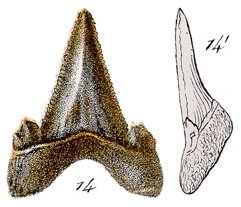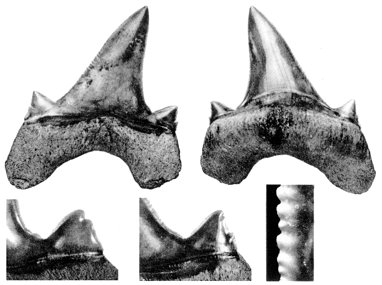(AGASSIZ, 1843) (Selachii: Otodontidae) teeth during the Early Eocene
the transition from Otodus obliquus (AGASSIZ, 1843) to
Carcharocles auriculatus (BLAINVILLE, 1818)
Jim Bourdon, David Ward & Gary Grimsley © 2000 & 05
A Paleo-obsession, the Early Years
Overview
Entering the new millennium, the interpretation of the elasmobranch fossil record remains largely an art. Despite the clues provided by sharks' teeth, their interpretation continues to be highly subjective. The lamniformes tend to receive the greatest attention because they produced the super-predators of past and present. The origins of the Recent great white shark, Carcharodon, and its relationship to other megatoothed Cenozoic sharks (i.e., Carcharocles1) provoke discussions 2. One of the pivotal points in this evolution occurs in the Early Eocene with the appearance of the first serrate-toothed species of Carcharocles. Two points-of-view dominate this discussion, 1) the species was derived from Otodus and 2) the species was derived from Palaeocarcharodon. To resolve these opposing views, we must consider both morphology and the fossil record.
 |
Morphology
A superficial examination of these teeth supports the second option, that Carcharocles was derived from Palaeocarcharodon, with their rather raggedly serrated teeth. However, the teeth of Palaeocarcharodon share few other characters and differ in many others. In particular, Palaeocarcharodon teeth are labio-lingually compressed and have a narrower neck. In contrast, the teeth of Otodus and the early species of Carcharocles are almost identical, excepting the serration.
The fossil record
Palaeocarcharodon teeth first appear in sediments of late Danian age (early Palaeocene - c 62Mya) and disappear in the early Thanetian (late Palaeocene - c 56.5Mya). This is five million years before the appearance of the first serrated Carcharocles teeth. If we were to suppose that Carcharocles was derived from Palaeocarcharodon, we have to explain this long gap in the fossil record. There are, however, intermediate morphologies between Otodus and Carcharocles, which are discussed below.
Thus Palaoecarcharodon as an ancestor of Carcharocles runs in the face of both morphology and the fossil record and is rejected.
So when did Otodus serrate?
There are very few published figures of teeth bridging the gap between the last Otodus and earliest examples of Carcharocles. This is because sediments of mid-Ypresian age (early Eocene) are fairly uncommon. This was a time of rapidly changing but generally low global sea levels. In the USA, the clays and silts of the Nanjemoy Formation are early Eocene in age. In Belgium, the silty Ieper Formation, and in NW Kazakhstan, the clays and marls of the Emba River region (Alaschen and Tolagaysor formations) are of a similar age.
It is only recently that Russian literature and localities in the former Soviet Union have become available to Westerners. Although published in 1928, figuring and describing Ypresian sharks' teeth, the paper of Menner, is almost unknown. Menner figured a tooth from the Ypresian of NW Kazakhstan, which he called Carcharodon toliapicus mut. ak-suatica3.

 |
Fig. 3 (right) - Menner syntype of C. aksuatucus |
Casier (1950) figured a lightly serrated upper lateral tooth from the Belgian middle Ypresian, which he referred to Lamna obliqua mutation subserrata. Using current terminology, we would refer to it as Carcharocles aksuaticus (MENNER, 1928)
 |
A consequence of this taxonomic point transcends the Otodus discussion but must, at least, be pointed out. Not only are the serrated Otodus teeth not subserratus, but the teeth commonly referred to as "Isurus" escheri might more correctly be called Carcharodon subserratus4. (Refer to the accompanying appendix, Opening a Bag of Worms — O. subserratus, for additional comments.)
Whether or not the appearance of serrations on Otodus teeth represents a unique bio-species or merely a chrono- or morphospecies/genus is also off topic. In order to lend clarity to this discussion, the authors deemed it appropriate to employ the (morpho-)species C. aksuaticus5. This (virtually unrecognized) species was erected for partially serrate Otodus teeth from the Early Eocene of the former Soviet Union.6 For slightly older teeth, with less recognizable and irregular serrae, we are using the name Otodus mugodzharicus.
| 1 | The authors subscribe to the opinion that serrated members of the Otodus lineage of megatoothed sharks should be attributed to the genus Carcharocles rather than Carcharodon. This is not the subject of this webpage, and the reader should feel free to synonymize these names. |
| 2 | Refer to the "Carcharodon vs Carcharocles" pages in the Topics section the elasmo.com website. |
| 3 | Menner was unaware that the tooth, originally described as Carcharodon toliapicus by Agassiz, supposedly from the Early Eocene London Clay of England, was not from the London Clay, but a much younger formation. See Zhelezko & Kozlov 1999: 145. This specimen, originally housed in Bristol Museum, UK, was destroyed by German bombing during the Second World War |
| 4 | We are not advocating a name change at this time. We are merely pointing out the potential consequences of these details. |
| 5 | see Zhelesko (1999 p. 144 - [in Russian]) or accompanying translation. |
| 6 | The Russians prefer using Otodus for the lineage from obliquus to megalodon. Despite strong arguments that support this position, the authors felt that there was only just so much one webpage could handle. |